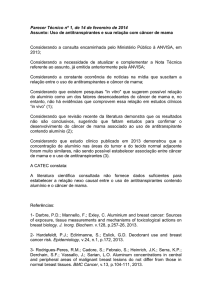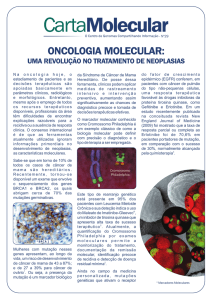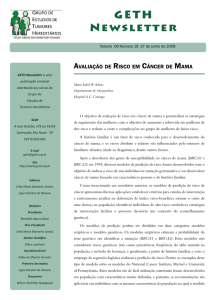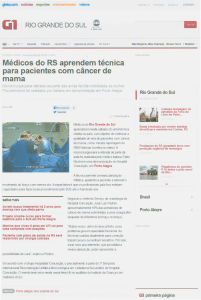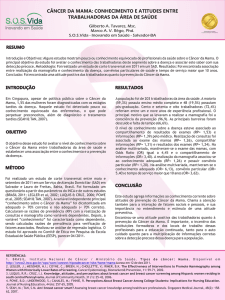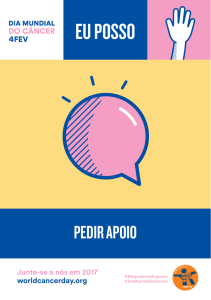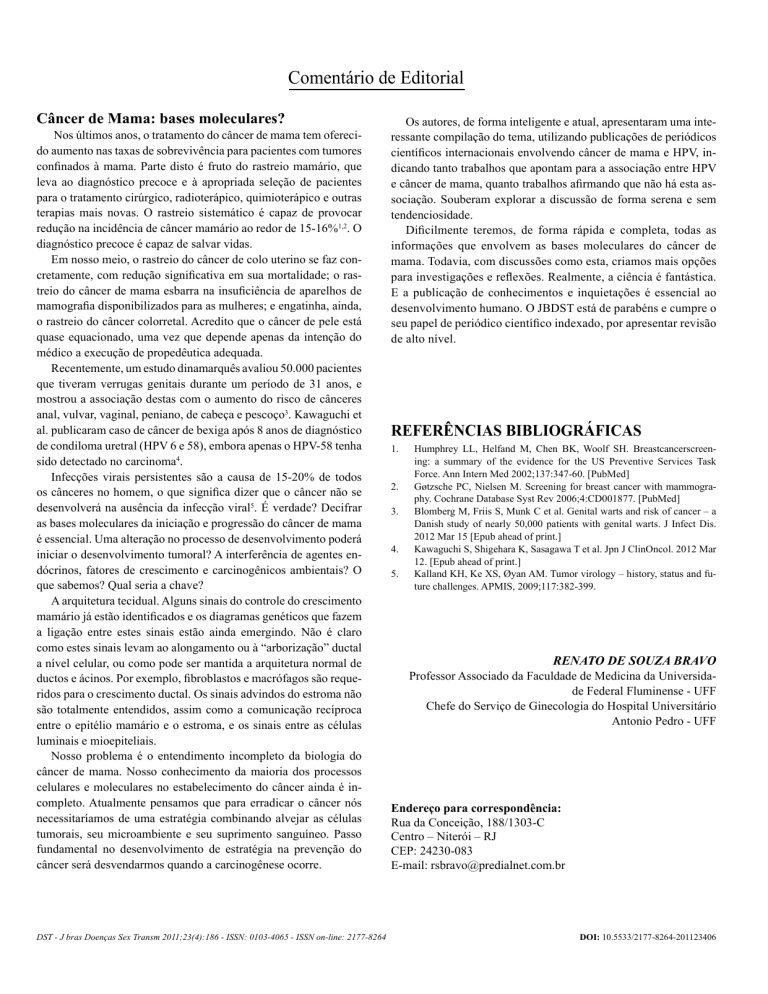
Comentário de Editorial
Câncer de Mama: bases moleculares?
Nos últimos anos, o tratamento do câncer de mama tem oferecido aumento nas taxas de sobrevivência para pacientes com tumores
confinados à mama. Parte disto é fruto do rastreio mamário, que
leva ao diagnóstico precoce e à apropriada seleção de pacientes
para o tratamento cirúrgico, radioterápico, quimioterápico e outras
terapias mais novas. O rastreio sistemático é capaz de provocar
redução na incidência de câncer mamário ao redor de 15-16%1,2. O
diagnóstico precoce é capaz de salvar vidas.
Em nosso meio, o rastreio do câncer de colo uterino se faz concretamente, com redução significativa em sua mortalidade; o rastreio do câncer de mama esbarra na insuficiência de aparelhos de
mamografia disponibilizados para as mulheres; e engatinha, ainda,
o rastreio do câncer colorretal. Acredito que o câncer de pele está
quase equacionado, uma vez que depende apenas da intenção do
médico a execução de propedêutica adequada.
Recentemente, um estudo dinamarquês avaliou 50.000 pacientes
que tiveram verrugas genitais durante um período de 31 anos, e
mostrou a associação destas com o aumento do risco de cânceres
anal, vulvar, vaginal, peniano, de cabeça e pescoço3. Kawaguchi et
al. publicaram caso de câncer de bexiga após 8 anos de diagnóstico
de condiloma uretral (HPV 6 e 58), embora apenas o HPV-58 tenha
sido detectado no carcinoma4.
Infecções virais persistentes são a causa de 15-20% de todos
os cânceres no homem, o que significa dizer que o câncer não se
desenvolverá na ausência da infecção viral5. É verdade? Decifrar
as bases moleculares da iniciação e progressão do câncer de mama
é essencial. Uma alteração no processo de desenvolvimento poderá
iniciar o desenvolvimento tumoral? A interferência de agentes endócrinos, fatores de crescimento e carcinogênicos ambientais? O
que sabemos? Qual seria a chave?
A arquitetura tecidual. Alguns sinais do controle do crescimento
mamário já estão identificados e os diagramas genéticos que fazem
a ligação entre estes sinais estão ainda emergindo. Não é claro
como estes sinais levam ao alongamento ou à “arborização” ductal
a nível celular, ou como pode ser mantida a arquitetura normal de
ductos e ácinos. Por exemplo, fibroblastos e macrófagos são requeridos para o crescimento ductal. Os sinais advindos do estroma não
são totalmente entendidos, assim como a comunicação recíproca
entre o epitélio mamário e o estroma, e os sinais entre as células
luminais e mioepiteliais.
Nosso problema é o entendimento incompleto da biologia do
câncer de mama. Nosso conhecimento da maioria dos processos
celulares e moleculares no estabelecimento do câncer ainda é incompleto. Atualmente pensamos que para erradicar o câncer nós
necessitaríamos de uma estratégia combinando alvejar as células
tumorais, seu microambiente e seu suprimento sanguíneo. Passo
fundamental no desenvolvimento de estratégia na prevenção do
câncer será desvendarmos quando a carcinogênese ocorre.
DST - J bras Doenças Sex Transm 2011;23(4):186 - ISSN: 0103-4065 - ISSN on-line: 2177-8264
Os autores, de forma inteligente e atual, apresentaram uma interessante compilação do tema, utilizando publicações de periódicos
científicos internacionais envolvendo câncer de mama e HPV, indicando tanto trabalhos que apontam para a associação entre HPV
e câncer de mama, quanto trabalhos afirmando que não há esta associação. Souberam explorar a discussão de forma serena e sem
tendenciosidade.
Dificilmente teremos, de forma rápida e completa, todas as
informações que envolvem as bases moleculares do câncer de
mama. Todavia, com discussões como esta, criamos mais opções
para investigações e reflexões. Realmente, a ciência é fantástica.
E a publicação de conhecimentos e inquietações é essencial ao
desenvolvimento humano. O JBDST está de parabéns e cumpre o
seu papel de periódico científico indexado, por apresentar revisão
de alto nível.
REFERÊNCIAS BIBLIOGRÁFICAS 1.
2.
3.
4.
5.
Humphrey LL, Helfand M, Chen BK, Woolf SH. Breastcancerscreening: a summary of the evidence for the US Preventive Services Task
Force. Ann Intern Med 2002;137:347-60. [PubMed]
Gøtzsche PC, Nielsen M. Screening for breast cancer with mammography. Cochrane Database Syst Rev 2006;4:CD001877. [PubMed]
Blomberg M, Friis S, Munk C et al. Genital warts and risk of cancer – a
Danish study of nearly 50,000 patients with genital warts. J Infect Dis.
2012 Mar 15 [Epub ahead of print.]
Kawaguchi S, Shigehara K, Sasagawa T et al. Jpn J ClinOncol. 2012 Mar
12. [Epub ahead of print.]
Kalland KH, Ke XS, Øyan AM. Tumor virology – history, status and future challenges. APMIS, 2009;117:382-399.
Renato de Souza Bravo
Professor Associado da Faculdade de Medicina da Universidade Federal Fluminense - UFF
Chefe do Serviço de Ginecologia do Hospital Universitário
Antonio Pedro - UFF
Endereço para correspondência:
Rua da Conceição, 188/1303-C
Centro – Niterói – RJ
CEP: 24230-083
E-mail: [email protected]
DOI: 10.5533/2177-8264-201123406
Editorial Comment
Breast cancer: molecular basis?
In recent years, the treatment of breast cancer has given increase
in survival rates for patients with tumors confined to the breast.
Part of this is the result of breast screening, leading to early diagnosis and appropriate patient selection for surgery, radiotherapy,
chemotherapy and other newer therapies. The systematic screening
is capable of causing reduction in the incidence of breast cancer is
around 15-16%(1,2). Early diagnosis can save lives.
In our setting, screening for cervical cancer is done concretely, with a significant reduction in their mortality, the screening of
breast cancer is barred by the lack of mammography equipment
available to women, and crawls, although the screening of colorectal cancer. I believe that skin cancer is almost solved, since it
depends only on the intention of the practitioner performing appropriate workup.
Recently, a Danish study evaluated 50,000 patients who had
genital warts over a period of 31 years, and showed a combination of both with an increased risk of anal cancer, vulvar, vaginal,
penile Head and pescoço(3). Kawaguchi et al. had published cases
of bladder cancer after eight years of diagnosis of urethral condyloma (HPV 6 and 58), although only the HPV-58 was detected
in carcinoma(4).
Persistent viral infections are the cause of 15-20% of all cancers in men, which means that the cancer will not develop in the
absence of infection viral(5). Is it true? Deciphering the molecular
bases of the initiation and progression of breast cancer is essential. A change in the development process may initiate tumor development? The interference of endocrine agents, growth factors
and environmental carcinogens? What do we know? What would
be the key?
The tissue architecture. Some signs of the control of mammary growth have already been identified and genetic diagrams that
make the connection between these signs are still emerging. It is
unclear how these signals lead to stretching or “afforestation” ductal the cellular level, or as may be maintained at normal architecture of ducts and acini. For example, fibroblasts and macrophagesare
required for growth duct. The signals from the stroma are not fully
understood, as well as two-way communication between the mammary epithelium and stroma, and the signals between luminal and
myoepithelial cells.
Our problem is the incomplete understanding of the biology of
breast cancer. Our knowledge of most cellular and molecular processes in the establishment of cancer is still incomplete. Currently
thought to eradicate cancer we would need a strategy combining
target tumor cells, their microenvironment and its blood supply.
Key step in the development strategy in cancer prevention will unfold when carcinogenesis occurs.
The authors, using a intelligently and present way, had an interesting compilation of the theme, using publications in international scientific journals involving breast cancer and HPV, indicating
that both studies show the association between HPV and breast
cancer, as saying that there is no work in this association. Able to
exploit the discussion calmly and without bias.
Hardly will, quickly and completely, all information involving
the molecular basis of breast cancer. However, with discussions
like this, create more options for investigations and reflections. Indeed, science is fantastic. And the publication of knowledge and
concerns is essential to human development. The JBDST is to be
congratulated for fulfills its role as a journal indexed and for presenting high-level review.
REFERENCES
1.
2.
3.
4.
5.
Humphrey LL, Helfand M, Chen BK, Woolf SH. Breastcancerscreening: a summary of the evidence for the US Preventive Services Task
Force. Ann Intern Med 2002;137:347-60. [PubMed]
Gøtzsche PC, Nielsen M. Screening for breast cancer with mammography. Cochrane Database Syst Rev 2006;4:CD001877. [PubMed]
Blomberg M, Friis S, Munk C et al. Genital warts and risk of cancer – a
Danish study of nearly 50,000 patients with genital warts. J Infect Dis.
2012 Mar 15 [Epub ahead of print.]
Kawaguchi S, Shigehara K, Sasagawa T et al. Jpn J Clin Oncol. 2012 Mar
12. [Epub ahead of print.]
Kalland KH, Ke XS, Øyan AM. Tumor virology – history, status and future challenges. APMIS, 2009;117:382-399.
Renato de Souza Bravo
Professor Associado da Faculdade de Medicina da Universidade Federal Fluminense - UFF
Chefe do Serviço de Ginecologia do Hospital Universitário
Antonio Pedro - UFF
Address correspondence to:
Rua da Conceição, 188/1303-C
Centro – Niterói – RJ
CEP: 24230-083
E-mail: [email protected]
DST - J bras Doenças Sex Transm 2011;23(4):187

